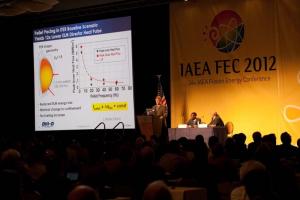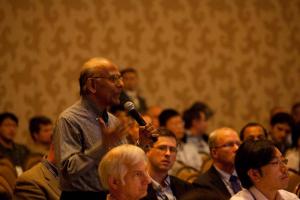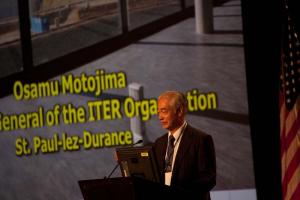We were all very interested in the new data on disruptions and runaway electrons that the teams working at JET, Alcator C-Mod, DIII-D and T-10, as well as other machines, have accumulated. Innovative techniques are being developed to minimize the impact of the runaway beams on the plasma-facing materials on DIII-D, which is good news for our community. The effectiveness of a second gas valve to reduce the asymmetry in the radiated power during a disruption was studied on C-Mod.
The disruption observations from JET indicate that there are significant differences between a carbon divertor and a tungsten divertor. The plasma current decays more slowly and the vertical position also evolves more slowly. This is probably related to the decreased radiated power—however, the duration of the halo currents is greater.
An intriguing result from analysis of
NSTX disruptions is that 98 percent of disruptions can be flagged with at least 10 ms of warning with only 6 percent of false positives.
These results combined with other results on disruption mitigation give greater confidence that a sufficiently reliable disruption mitigation system can be developed for ITER, though further work is needed.
An increasing body of fundamental knowledge is also being accumulated in the field of ELM control, which will lead us to re-evaluate how to either mitigate the impact of, or preferably suppress, ELMs by means of the in-vessel coils. ASDEX Upgrade, DIII-D and
MAST are strongly contributing to this exploration and understanding as well as theorists from around the world. In addition, interesting new data using other techniques, including pellet injection, to control
ELMs were shown by DIII-D, EAST and KSTAR.
Increasingly detailed analysis of stability and confinement characteristics of
H-mode plasmas are advancing in impressive fashion: the conference heard of the remarkable agreement between the predictions of the "EPED" code and measurements of limiting pedestal pressure in many tokamak experiments.
An interesting new analysis of the influence of isotopic mass on the confinement characteristics of H-mode plasmas was also reported from JT-60U, and striking results from nonlinear 3D modelling of individual ELMs with the JOREK code were also presented. An extensive review of recent data on the dependence of the H-mode power threshold carried out by the
ITPA will also give us food for thought.




